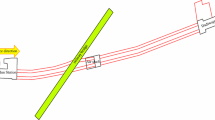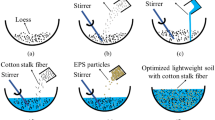Abstract
The construction of a slurry shield tunnel produces large amount of excavated soil. Direct discharge of the excavated soil by transportation not only increases the overall construction cost but also raises environmental concerns of pollution. In this study, we explore in-situ recycle of excavated soil in the Nanjing Yangtze River tunnel project as the back-fill grout. A series of laboratory were carried out to determine the synchronous grout parameters, including compression strength and shear strength, initial setting time, fluidity, consistency, and bleeding rate. The mixture ratio of the back-fill grout is also discussed to optimize the grout performance. It is found that: (1) the excavated soil produced from the construction of slurry shield tunnel in this project can be reused as the material of back-fill grout in the sand stratum; (2) Proper selection of binder/sand ratio and fly ash/cement ratio improves the performance of the synchronous grout. The test results demonstrated that the discharged soil can be recycled in-situ as the grouting material in the sand stratum.
Similar content being viewed by others
References
Arnau, O., Molins, C., Blom, C. B. M., and Walraven, J. C. (2012). “Longitudinal time-dependent response of segmental tunnel linings.” Tunnelling and Underground Space Technology, Vol. 28, pp. 98–108, DOI: 10.1016/j.tust.2011.10.002.
Bezuijen, A. and Talmon, A. M. (2013). “Grout properties and their influence on back fill grouting.” Proceedings of the 5th International Symposium on Geotechnical Aspects of Underground Construction in Soft Ground, pp. 187–193.
Bezuijen, A., Talmon, A. M., Kaalberg, F., and Plugge, R. (2004). “Field measurements of grout pressures during tunneling of the Sophia rail tunnel.” Soils and Foundations, Vol. 44, No. 1, pp. 39–48, DOI: 10.3208/sandf. 44.39.
Bezuijen, A., Van Der Zon W. H., and Talmon, A. M. (2005). “Laboratory testing of grout properties and their influence on back fill grouting. Tunnelling.” A Decade of Progress. GeoDelft 1995-2005, 115, pp. 941–947.
Ding, W. Q., Yue, Z. Q., Tham, L. G., Zhu, H. H., Lee, C. F., and Hashimoto, T. (2004). “Analysis of shield tunnel.” International Journal for Numerical and Analytical Methods in Geomechanics, Vol. 28, No. 1, pp. 57–91, DOI: 10.1002/nag.327.
Ji, Chang, Zhou, S.-H., and Xu, Kai etc (2013). “Field test research on influence factor of upward moving of shield tunnel segments during construction.” Chinese Journal of Rock Mechanics and Engineering, Vol. 32, No. S2, pp. 3619–3626.
Komiya, K., Soga, K., Akagi, H., Jafari, M. R., and Bolton, M. D. (2001). “Soil consolidation associated with grouting during shield tunnelling in soft clayey ground.” Geotechnique, Vol. 51, No. 10, pp. 835–846, DOI: 10.1680/geot.2001.51.10.835.
Koyama, Y. (2003). “Present status and technology of shield tunneling method in Japan.” Tunnelling and Underground Space Technology, Vol. 18, No. 2, pp. 145–159, DOI: 10.1016/S0886-7798(03)00040-3.
Koyama, Y., Sato, Y., Okano, N., and Shimizu, M. (1998). “Back-fill grouting model test for shield tunnel.” Quarterly Report-rtri, Vol. 39, No. 1, pp. 35–39.
Li, X., Tian, Z., Yang, Z., and Li, X. (2014). “Observed ground pressures and internal forces of the shanghai yangtze river tunnel.” Geo-Shanghai, Tunneling and Underground Construction, ASCE. pp. 984–992, DOI: 10.1061/9780784413449.098.
Li, X., Zhou, S. H., Gong, Q. M., and Chen, C. J. (2015). “Evaluation of earth pressure around a deeply buried metro shield tunnel with a large cross-section under high water pressure conditions.” Rock and Soil Mechanics, Vol. 36, No. 5, pp. 1415–1420, DOI: 10.16285/j.rsm.2015.05.025.
Lin, C., Wu, S., and Xia, T. (2015). “Design of shield tunnel lining taking fluctuations of river stage into account.” Tunnelling and Underground Space Technology, Vol. 45, pp. 107–127, DOI: 10.1016/j.tust.2014.09.011.
Martinelli, D., Peila, D., and Campa, E. (2015). “Feasibility study of tar sands conditioning for earth pressure balance tunneling.” Journal of Rock Mechanics and Geotechnical Engineering, Vol. 7, No. 6, pp. 684–690, DOI: 10.1016/j.jrmge.2015.09.002.
Melis, M., Medina, L., and Rodríguez, J. M. (2002). “Prediction and analysis of subsidence induced by shield tunnelling in the Madrid Metro extension.” Canadian Geotechnical Journal, Vol. 39, No. 6, pp. 1273–1287, DOI: 10.1139/t05-043.
Min, F., Zhu, W., Lin, C., and Guo, X. (2015). “Opening the excavation chamber of the large-diameter size slurry shield: A case study in Nanjing Yangtze River Tunnel in China.” Tunnelling and Underground Space Technology, Vol. 46, pp. 18–27, DOI: 10.1016/j.tust.2014.10.002.
Peila, D., Borio, L., and Pelizza, S. (2011). “The behaviour of a twocomponent backlling grout used in a Tunnel-Boring Machine.” Acta Geotechnica Slovenica, Vol. 1, pp. 5–15, DOI: http://porto.polito.it/2435575.
Peila, D., Chieregato, A., Martinelli, D., Onate Salazar, C., Shah, R., Boscaro, A., Dal Negro, E., and Picchio, A. (2015). “Long term behavior of two component back-fill grout mix used in full face mechanized tunneling.” Geoingegneria Ambientale e Mineraria, Vol. 144, No. 1, pp. 57–63. ISSN: 1121-9041
Pelizza, S., Peila, D., Borio, L., Dal Negro, E., Schulkins, R., and Boscaro, A. (2010). “Analysis of the performance of two component backfilling grout in tunnel boring machines operating under face pressure.” Proceedings of ITA-AITES World Tunnel Congress 2010: “Tunnel visiontowards 2020”, Vancouver, pp. 14–20.
Ramoni, M., Lavdas, N., and Anagnostou, G. (2011). “Squeezing loading of segmental linings and the effect of backfilling.” Tunnelling and Underground Space Technology, Vol. 26, No. 6, pp. 692–717, DOI: 10.1016/j.tust.2011.05.007.
Shirlaw, J. N., Richards, D. P., Ramon, P., and Longchamp, P. (2004). “Recent experience in automatic tail void grouting with soft ground tunnel boring machines.” Proceedings of the ITA-AITES World Tunnel Congress, Singapore, pp. 22–27.
Shunhua, Zhou and Chang, Ji (2014). “Tunnel segment uplift model of earth pressure balance shield in soft soils during subway tunnel construction.” International Journal of Rail Transportation, Vol. 2, No. 4, pp. 221–238, DOI: 10.1080/23248378.2014.966420.
Song, T.-T., Zhou, S.-H., and Xu, R.-Z. (2008). “Mechanism and determination of parameters of synchronous grouting in Shield Tunneling.” Chinese Journal of Underground Space and Engineering, Vol. 4, No. 1, pp. 130–133, DOI: 10.3969/j.issn.1673-0836.2008.01.025.
Thewes, M. and Budach, C. (2009). “Grouting of the annular gap in shield tunnelling-An important factor for minimisation of settlements and production performance.” Proceedings of the ITA-AITES World Tunnel Congress 2009 “Safe Tunnelling for the City and Environment”, pp. 1–9.
Vinai, R., Oggeri, C., and Peila, D. (2008). “Soil conditioning of sand for EPB applications: A laboratory research.” Tunnelling and Underground Space Technology, Vol. 23, No. 3, pp. 308–317, DOI: 10.1016/j.tust.2007.04.010.
Zhong, X.-C., Zuo J., Liu, Q.-W., and HAN, Y. W. (2008). “Reuse of excavated fine sand for back grouting of shield tunnelling.” Rock and Soil Mechanics, Vol. 29, No. S1, pp. 293–296, DOI: 10.3969/j.issn.1000-7598.2008.z1.059.
Author information
Authors and Affiliations
Corresponding author
Rights and permissions
About this article
Cite this article
Zhou, S., Li, X., Ji, C. et al. Back-fill grout experimental test for discharged soils reuse of the large-diameter size slurry shield tunnel. KSCE J Civ Eng 21, 725–733 (2017). https://doi.org/10.1007/s12205-016-0856-z
Received:
Revised:
Accepted:
Published:
Issue Date:
DOI: https://doi.org/10.1007/s12205-016-0856-z




